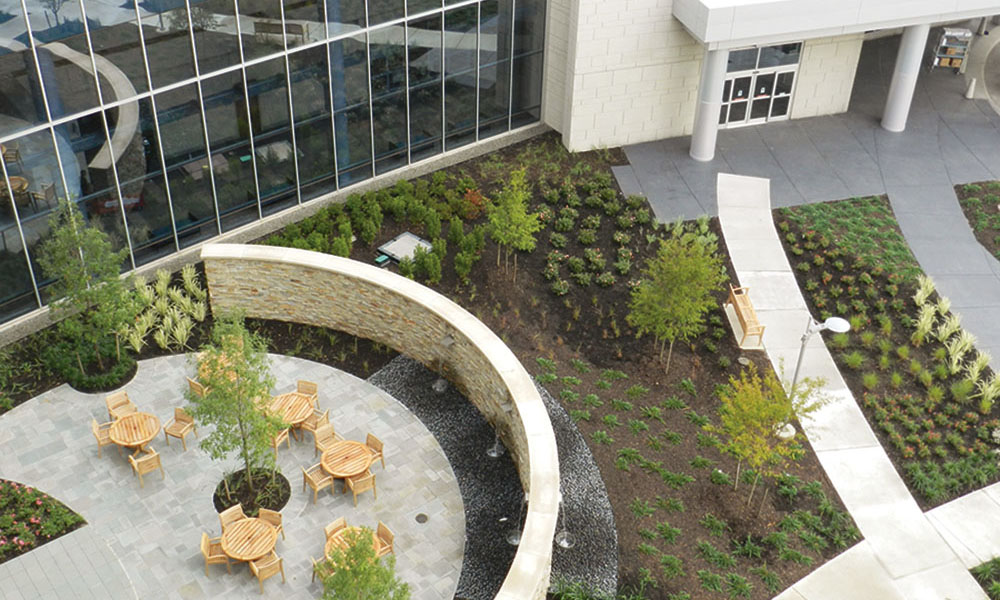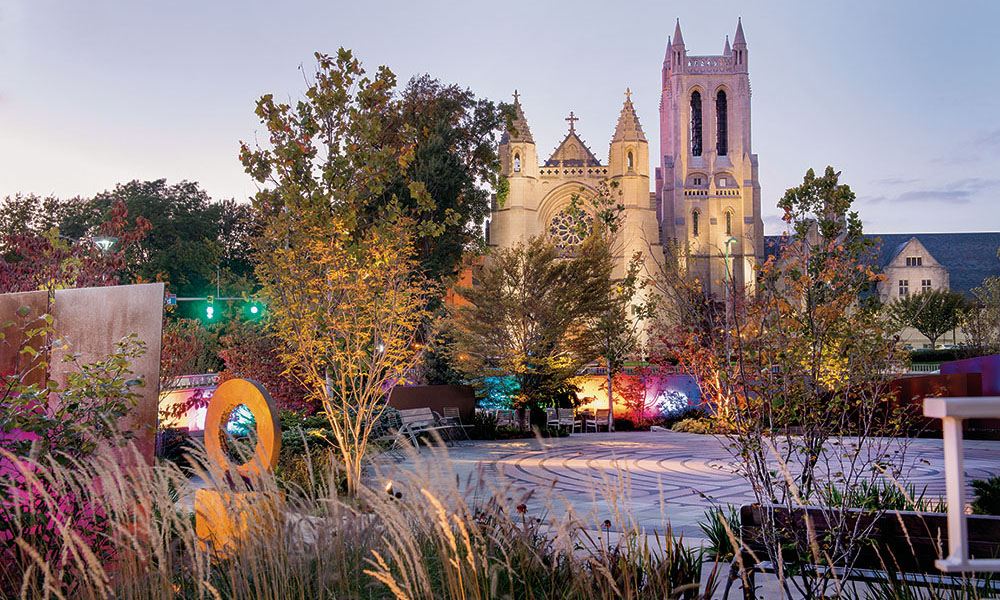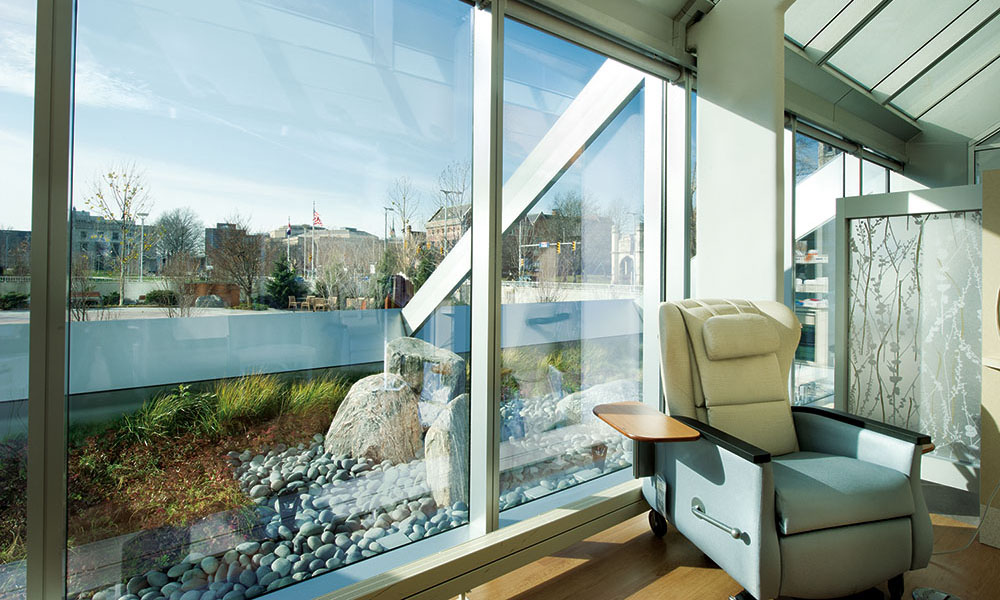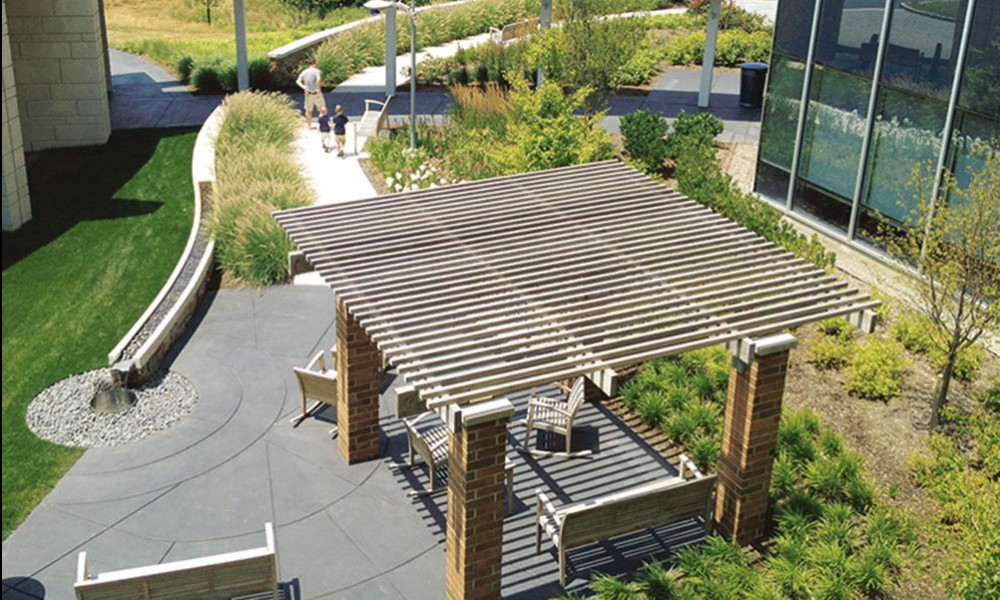Ecotherapy: Healing the body by healing the Earth
The term “biophilia,” which literally translates as “love of life or living systems,” is used to describe the theory that suggests there is an instinctive bond between human beings and other living systems and that this bond is essential to good physical and mental health.1 We have a natural attraction to all that is alive and vital — all humans have “the urge to affiliate with other forms of life.”2 This premise helps explain why many spend time and energy caring for plants and flowers in their homes … in other words, our natural love for life helps us sustain life.
Since these ephemeral theories were first postulated in the 1980s, scientific research has served to validate the measurable benefits of connecting with the natural world. As professionals, we challenge ourselves to go beyond the standard, simple visualization of nature in the built environment and provide actual physical links to nature. A recent article in The New York Times touted the health benefits of immersing oneself in the natural environment. The article discussed a study that included data on 280 healthy people in Japan, where visiting nature parks for therapeutic effect has become a popular practice called “shinrin-yoku,” or “forest bathing.” The scientists found that being among plants produced “lower concentrations of [the stress hormone] cortisol, lower pulse rate, and lower blood pressure,” among other things.3
In the medical design/construction industry, one service line that has embraced this theory is cancer care. Almost every modern cancer center integrates some type of healing or meditation garden into its design in order to incorporate the life-affirming benefits of connecting with nature into the continuum of care. For many patients, their time in this environment has become an intrinsic and indispensable part of recovery or life-transition process.
However, to fully harness the healing potential of nature, we can go beyond basic “ecopsychology” (i.e., our psychological relationship with nature) into the participatory realm of “ecotherapy.”
As an umbrella term for nature-based methods of physical and psychological healing, ecotherapy points to the need to reinvent psychotherapy and psychiatry as if nature and the human-nature relationship matters. It takes into account the latest scientific understandings of the universe and the deepest indigenous wisdom. This perspective reveals the critical fact that people are intimately connected with, embedded in and inseparable from the rest of nature. Grasping this fact deeply shifts our understanding of how to heal the human psyche and the dysfunctional and even lethal human-nature relationship. It becomes clear that what happens to nature for good or ill impacts people and vice versa, leading to the development of new methods of individual and community psychotherapeutic diagnosis and treatment. Ecotherapeutic work takes guidance from an ecological circle of three mutually interacting operations or dynamics.4
Inreach: Receiving and being nurtured by the healing presence of nature, place, Earth.
Upreach: The actual experience of this more-than-human vitality as we relocate our place within the natural world.
Outreach: Activities with other people that care for the planet.
The application of these theories into actual practice includes several guiding values for caregivers that are in alignment with the physical and mental needs of cancer patients.
While it might be tempting to dismiss the use of ecotherapy as “tree-hugging” nonsense, there is an impressive research database affirming the psychological and physical benefits of gardening therapy. Ecotherapy work has been shown to ameliorate depression, lower blood pressure, enhance self-esteem, encourage new social behaviors, help with impulse control and decrease post-operative recovery time. Patients have offered favorable reports about ecotherapeutic work.5
Prescription for nature
Some healthcare providers have even begun giving patients “nature prescriptions” to help treat a variety of medical conditions, from post-cancer fatigue to obesity, hypertension (high blood pressure) and diabetes. Scientists have long known that sunlight can ease depression, especially seasonal affective disorder. New research is expanding those findings. A 2007 study from the University of Essex in the U.K., for example, found that a walk in the country reduces depression in 71 percent of participants. The researchers found that as little as five minutes in a natural setting, whether walking in a park or gardening in the backyard, improves mood, self-esteem and motivation.
Incorporating an ecotherapy program into a care plan is not dependent upon an abundance of available land or capital funding. The programs can be scaled to suit suburban and rural facilities with lots of landscape space or to challenging urban sites through the use of small container gardens or landscaped roofs. The effectiveness of a program is not generated by lavish facilities or excessive funding, but rather by the active participation of patients (both past and current). In fact, the starting point for such a program can often be a neglected, ignored or underutilized area that can be “healed” by those working the land.
The detailed design of an ecotherapy garden is something that will be unique to a care program and physical location. At the core, ecotherapy gardens should be functional, accessible, easily maintained, environmentally sound, cost effective, visually pleasing and, most importantly, supportive of the healing process. While the selection of species will be influenced by the plant hardiness zone, solar exposure and access to water, they can also be specifically aligned to support the functional needs of patients:
The healing and recovery process can be symbolized by choosing plants that have traditional, medicinal properties such as aloe vera, sage, lemon balm, milk thistle or comfrey.
Aromatic plants and flowers such as chamomile, lavender or peppermint can be utilized as a gentle, effective way to improve mental and emotional imbalances, enhance well-being and creativity.
Vitamin and antioxidant-rich fruits and vegetables like oranges, strawberries, spinach or artichokes can be incorporated into a dietary educational program.
The garden setting can be an inspirational setting for complementary alternative therapies like meditation, relaxation, visualization or yoga.
Due to unique disease and immune performance states, some patients may be prevented from being fully immersed in a garden environment, however visual access to the garden can still provide enrichment to this population. When combined with the astounding technological advances of modern medicine, an ecotherapy program can become a valuable piece of a comprehensive plan that cares equally for mind, body and spirit.
1. Fromm, Erich (1964). The Heart of Man. Harper & Row
2. Wilson, Edward O. (1984). Biophilia. Harvard University Press
3. O’Connor, Anahad (2010). “The Claim: Exposure to Plants and Parks Can Boost Immunity.” The New York Times
4. Clinebell, Howard (1996). Ecotherapy: Healing Ourselves, Healing the Earth. Routledge
5. Buzzell, Linda and Chalquist, Craig (2009). Ecotherapy: Healing with Nature in Mind.
Posted February 1, 2014
More Articles:
- Coverings 2024
Apr 22, 2024 – Apr 25, 2024 - Hospital, Outpatient Facilities & Medical Office Buildings Summit
Apr 25, 2024 – Apr 25, 2024 - CxA Workshop & Exam
Apr 29, 2024 – Apr 30, 2024 - EMP Seminar & Exam at CxEnergy 2024
Apr 29, 2024 – Apr 30, 2024 - CxEnergy
Apr 29, 2024 – May 2, 2024 - PHCC West 2024
Apr 29, 2024 – May 2, 2024 - Lean in Design Forum 2024
May 1, 2024 – May 2, 2024















